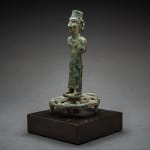Canaanite Bronze Figure of a Deity, 1400 BCE - 1000 BCE
Bronze
height 15.2 cm
height 6 in
height 6 in
LO.599
Further images
Elongated figurine cast in solid bronze depicted standing, the missing arms possibly bent forward, the long cloak with a v-shaped collar. The head surmounted by a conical headdress, the face...
Elongated figurine cast in solid bronze depicted standing, the missing arms possibly bent forward, the long cloak with a v-shaped collar. The head surmounted by a conical headdress, the face with deep inset almond-shaped eyes, long straight nose and small mouth, the earlobes each pierced by two dangling metal rings.
It is generally agreed that human figurines made of metal from the Levant are representations of deities. Since monumental stone sculptures are relatively rare in this area before the Hellenistic period, these figurines might be miniature replicas of wooden cult statues which have not survived the ravages of time. As such, metal figurines may have been used as votive images, given also the fact that they were mainly excavated from within ceremonial enclosures, hence suggesting their ritual connotation. It should also be noted that these images may have been used as amulets for magic purposes in domestic and funerary cults.
Already by the 3rd millennium BC, several kinds of metal were used in the Levant both for casting and hammering. Lead, copper and bronze were generally used for solid casting, while gold and silver for hammering. Most of the solid-cast figurines, such as this one, were made in stone or clay moulds and a few in lost-wax process. The technique of casting in permanent moulds differs markedly from the lost wax process, especially in time-expenditure and resource management. While the former could be used several times for casting, hence preferred for mass-produced artefacts, the latter would have been employed only once, with great skill, yielding a single piece of art that only the teocracy and the aristocracy could afford. Most of the hammered figurines were worked in repousse', a technique usually employed in sheet metal, hence producing mainly pendants and inlays. Sheet gold and silver were used also for coating solid cast figurines made of copper or bronze.
Most of the figurines coming from officially excavated sites would date to the 2nd millennium BC and would have originated in the Levantine coast and its immediate hinterland, from where a few reached Asia Minor, Delos, Cyprus, Crete and Greece. Geographical and chronological evidence may therefore justify their attribution to the Canaanites who besides other ethnic groups like the Amorites, Israelites and Phoenicians, constituted the dominant population of the area during this period. Given the style of the cloak, and the presence of double pierced earlobes, this figurine too could have been produced in Palestine, as similar examples come from the site of Megiddo, datable between the 15th and the 11th century BC.
For comparable examples cf Ora Negbi, Canaanite Gods in Metal, Tel Aviv, 1976: pp.50-52.
It is generally agreed that human figurines made of metal from the Levant are representations of deities. Since monumental stone sculptures are relatively rare in this area before the Hellenistic period, these figurines might be miniature replicas of wooden cult statues which have not survived the ravages of time. As such, metal figurines may have been used as votive images, given also the fact that they were mainly excavated from within ceremonial enclosures, hence suggesting their ritual connotation. It should also be noted that these images may have been used as amulets for magic purposes in domestic and funerary cults.
Already by the 3rd millennium BC, several kinds of metal were used in the Levant both for casting and hammering. Lead, copper and bronze were generally used for solid casting, while gold and silver for hammering. Most of the solid-cast figurines, such as this one, were made in stone or clay moulds and a few in lost-wax process. The technique of casting in permanent moulds differs markedly from the lost wax process, especially in time-expenditure and resource management. While the former could be used several times for casting, hence preferred for mass-produced artefacts, the latter would have been employed only once, with great skill, yielding a single piece of art that only the teocracy and the aristocracy could afford. Most of the hammered figurines were worked in repousse', a technique usually employed in sheet metal, hence producing mainly pendants and inlays. Sheet gold and silver were used also for coating solid cast figurines made of copper or bronze.
Most of the figurines coming from officially excavated sites would date to the 2nd millennium BC and would have originated in the Levantine coast and its immediate hinterland, from where a few reached Asia Minor, Delos, Cyprus, Crete and Greece. Geographical and chronological evidence may therefore justify their attribution to the Canaanites who besides other ethnic groups like the Amorites, Israelites and Phoenicians, constituted the dominant population of the area during this period. Given the style of the cloak, and the presence of double pierced earlobes, this figurine too could have been produced in Palestine, as similar examples come from the site of Megiddo, datable between the 15th and the 11th century BC.
For comparable examples cf Ora Negbi, Canaanite Gods in Metal, Tel Aviv, 1976: pp.50-52.





